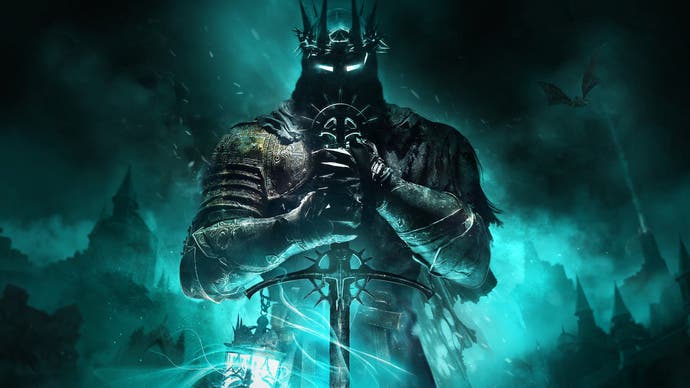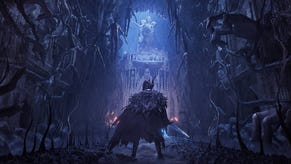Lords of the Fallen is a stunning UE5 Soulslike with ongoing tech issues
Patches keep on coming but Xbox in particular still needs a lot of work.
Almost a month on from its release, Lords of the Fallen is a visually stunning Soulslike that's still held back by ongoing technical issues on console - and that's a shame. After all, this 2023 series reboot is a rare breed of next-gen project designed just for PlayStation 5, Xbox Series X, S and PC. Added to that, the game is built on Unreal Engine 5 with a heavy use of its Nanite and Lumen technologies. Developer Hexworks goes all-out here in its world-building and the UE5 features allow for intricately detailed gothic environments, lit by a hybrid ray-traced global illumination technique. Add in a realm-switching mechanic - in the tradition of Legacy of Kain: Soul Reaver - and it makes sense that the game's ambition is perhaps beyond the scope of a last-gen console release.
In fact based on the evidence today, it's a big ask even on today's machines. Despite its technical achievements, Lords of the Fallen's launch has not been a smooth one - and even after almost a month's worth of patches on the console front, the game remains flawed as of version 1.1.293 (and even in our re-test of v1.1.310 as of publishing this article today) with clear frame-rate drops and issues in image quality.
With this in mind, it's time to finally tackle the PS5, Series X and Series S versions in turn, each fully patched up. A heads up that there are two modes included on every console, as is the trend these days: a 60fps performance mode and 30fps quality mode - and we'll be comparing both. In particular though, there's much to be said for the game's delivery of 60fps gameplay - with Series S especially coming out worse for wear.
Let's start with the Xbox Series S, where Lords of the Fallen's issues are truly hard to ignore in its current state. Even in the 60fps performance mode, the game fails to hit that top target most of the time - despite running at a dynamic 720p resolution with drops to 432p at lowest. I've seen 40-60fps readouts throughout the first tutorial portions of the game, before dropping to the mid-20s (!) in the first proper boss battle against Pieta. It's here, notably once Pieta starts summoning swords from the heavens, that we see the resolution go to its lowest value of 432p on Series S, just 60 percent of 720p. With such a low base pixel count to work with, the upscaler struggles and picture quality in motion is often quite poor.
This Pieta battle is the worst case I've encountered so far, as a repeatable scenario. If there is a silver lining, it's that Series S does actually manage to hit 60fps some of the time - in enclosed, smaller dungeons. The bigger issue is the frame-time delivery, with frame-rates at points dropping abruptly to cause a visible hitch mid-combat. In extreme cases, it's even possible for Series S to continuously run below 10fps as we move between major areas.
All of this appllies as of the latest update, 1.1.293, where these performance hang-ups are still a problem. After giving the Series S machine a complete reboot, and setting up a brand-new character it's not long before performance crashes to the single frame-rate digits. Playing for barely half an hour, I spotted a heavy lurch down to 5fps for a good stretch, just before the Pieta boss battle. More crucially though, the frame-time reading shows stutters in excess of 320ms - making the game near impossible to control for seconds at a time. These hang-ups are admittedly less common than they were at launch, but it happens often enough to be a major playability issue.
It's worth noting that online play is disabled for all testing - ruling out networking contention, so it's most likely that this is a memory or CPU bottleneck issue. The upside is that Hexworks' efforts to optimise the game are ongoing, with patch notes often pointing out memory useage improvements on console. For now however, the lurches in frame-rate during traversal and those mid-20s readings during the Pieta boss battle are something to be wary of on Series S.
Next along is Series X, which offers some good news to start: in practically every area where Series S drops into the 40s, Series X pushes a more solid 60fps reading. The mandatory tutorial bit, and the ruined village beyond it, are all typically at 60 - though later stress points like the Pieta boss battle and Skyrest hub pull Series X down to the 40fps region. Again it's rapid movement, plus the additional complex geometry of the Umbral realm, that cues bigger lurches. On average, the typical reading on Series X trends towards 60fps at least - while its performance mode's resolution is a dynamic 1152p, dropping to 648p lowest in GPU-taxing areas. Higher resolutions are possible too - and we saw one 1215p sample when looking at the sky - but this is the most typical range.
Unfortunately, there's a catch: hitching and performance hang-ups are an issue on Series X as well, notably in quick traversal. These drops aren't as frequent as on Series S and it appears to take a lot more play-time to reach the same low, single-digit levels. Still, it's impossible to ignore when it happens. To keep the test fair, again I started a fresh new character on my Series X run and played for two hours without significant issues. Eventually though, the game choked up - with performance dropping all the way down to 1fps after an extended sprint across the world. It's worse than any stretch I had on Series S, though, I suspect it's possible to hit a similar breaking point given enough time. As a quick fix, closing and restarting the app from the Xbox menu clears this sustained sub-10fps performance completely, and the adventure resumed at closer to 60fps again.
That aside, and otherwise, the frame-rate on Series X's performance mode typically rests at 60fps, with drops into the 40s.
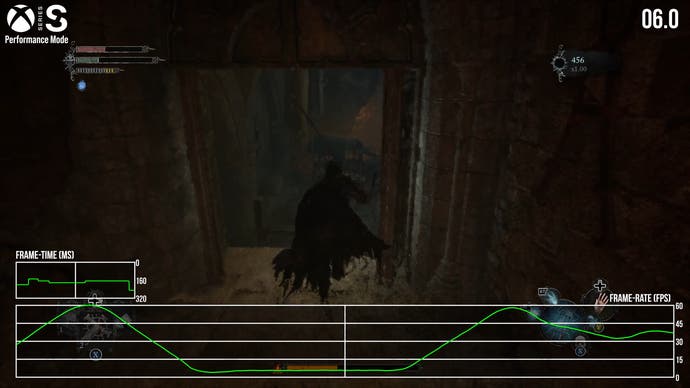
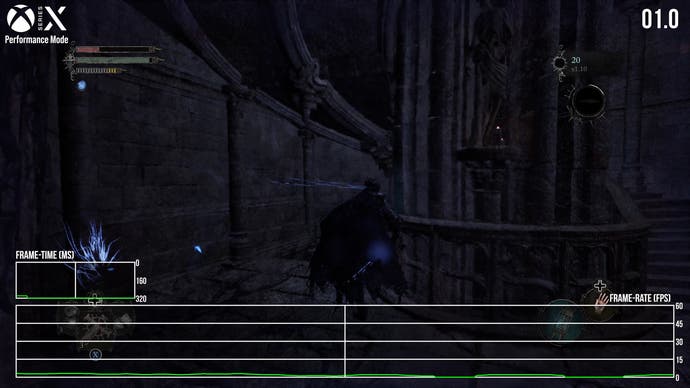
Sticking to performance testing, let's see PS5 in action. Both PS5 and Series X are identical in visual setup, so again it's an 1152p dynamic resolution with 648p as the lower bounds here. Frame-rates are also often a match for Series X: that is to say often it's at 60fps, but areas like the Skyrest Hub and Pilgrim's Perch eventually drop us into the 40s and 50s. The upside to playing on PS5 is that hitching is drastically reduced compared to the Xbox machines - and likewise I've yet to experience any similar sub-10fps hang-ups. As a disclaimer, it's not been possible to test the entirety of the game - and PS5 could very feasibly have issues later on. So far at least, the most obvious frame-time spikes are in response to traversal or realm-switching - spiking us to around 70ms - but I've yet to see any code red situations on a par with Series S or X.
As well as the 60fps performance mode, there's also a 30fps quality mode on every console. As you'd expect, this option flattens out the peaks and valleys of the performance mode to a mostly straight 30fps update, the catch being that it runs with uneven frame-pacing. These fluctuations in frame-time, between 16-50ms are obvious enough that I'd recommend the 60fps performance mode overall. Despite its boosts in resolution, the wavering frame-times mean the quality mode doesn't feel particularly smooth in motion.
Talking on the visual advantages with the quality mode, PS5 and Series X get a boost to a dynamic 1620p, with drops to 1296p at lowest. It's a clearly visible upgrade, and the higher pixel count allows each machine to reconstruct a more convincing 4K image (via AMD's FSR2 or Unreal's TAAU, which are both available on PC). Series S is also enhanced in its quality mode with a dynamic 972p image, though visibility still suffers on Series S when it drops to its 648p lower end in this mode. Also, all three consoles still exhibit hitches and hang-ups at points with this 30fps cap in place. It's not entirely problem solved - especially during quick traversal where hitches flare up most - though these issues do at least seem to be partially disguised by the 30fps cap.
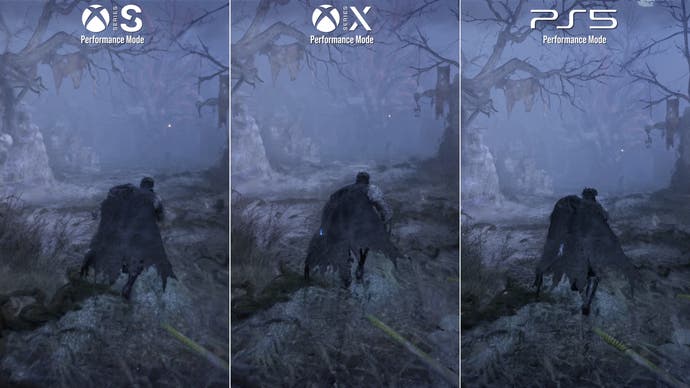
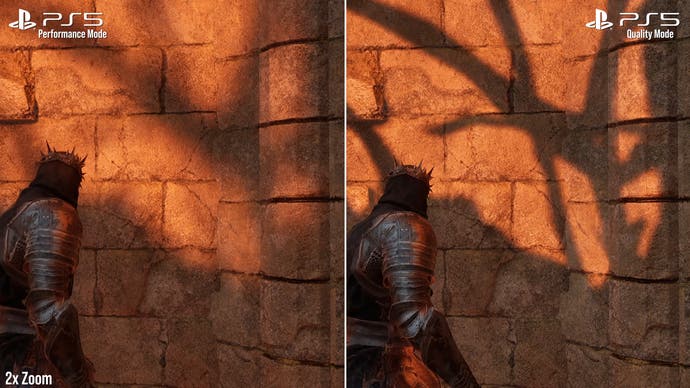
There are a few other upsides to running at 30fps too, including boosts to world shadow quality, particularly noticeable on sun-cast shadows, while volumetric lighting runs at a higher resolution, reducing stair-stepping across streaks of light. Screen space reflections (SSR) also see a similar boost in quality, clearing up the mirror image in puddles. There are rare upgrades in shadow and geometry LODs too, but out of all of these, it's truly the resolution boost and clearer shadows that make the difference. As a side-note, motion blur, chromatic aberration and film grain are toggleable in the menus, which is helpful for Digital Foundry comparisons and antifans of these effects.
The final question then: how do the consoles compare? Taking the 60fps performance mode as an example, there's little to split Series X and PS5 visually. At launch PS5 was missing grass - inexplicably - but on the latest build it's been reintroduced and the premium consoles are now on par. Even the resolution range is a match between the two, on each mode. Let's call this a draw.
It's the comparisons with Series S that are more revealing. At peak we're hitting 720p, with 432p as the extreme lowest figure as mentioned earlier, and even after reconstruction this results in some of the muddiest image quality I've seen on the platform. Fundamentally, this is the price we have to pay for a 4TF console to push a matching feature set to PS5 and Series X. We get Nanite, Lumen and the option to render it out at 60fps, but the turnout is not always flattering on modern displays.

In comparison with Series X's own performance mode, Series S struggles to match up in image quality. It also takes a visible cut in settings elsewhere, with lower-quality volumetric effects, lower texture quality and even lower-grade geometry cave formations. Combined with the low resolution image and performance struggles, it's clear that the Series S version's push for 60fps isn't a successful one right now.
Despite several patches being logged to its name already, the Lords of the Fallen reboot unfortunately still has plenty of issues on console. It's a shame though, given it ekes out beautiful results from Unreal Engine 5's tech. This game is unusually ambitious for a Soulslike in terms of visuals and mechanics, and UE5's nanite in particular paves the way for two beautifully-detailed worlds rendered in parallel. Right now though this isn't enough to redeem the hang-ups, hitches and sub-60fps frame-rates we're seeing. It's still a compromised experience on PS5 and Series X today, and once again Xbox Series S finds itself out of its depth in attempting to balance performance with visual quality.
